2017 NISSAN LEAF sensor
[x] Cancel search: sensorPage 9 of 424
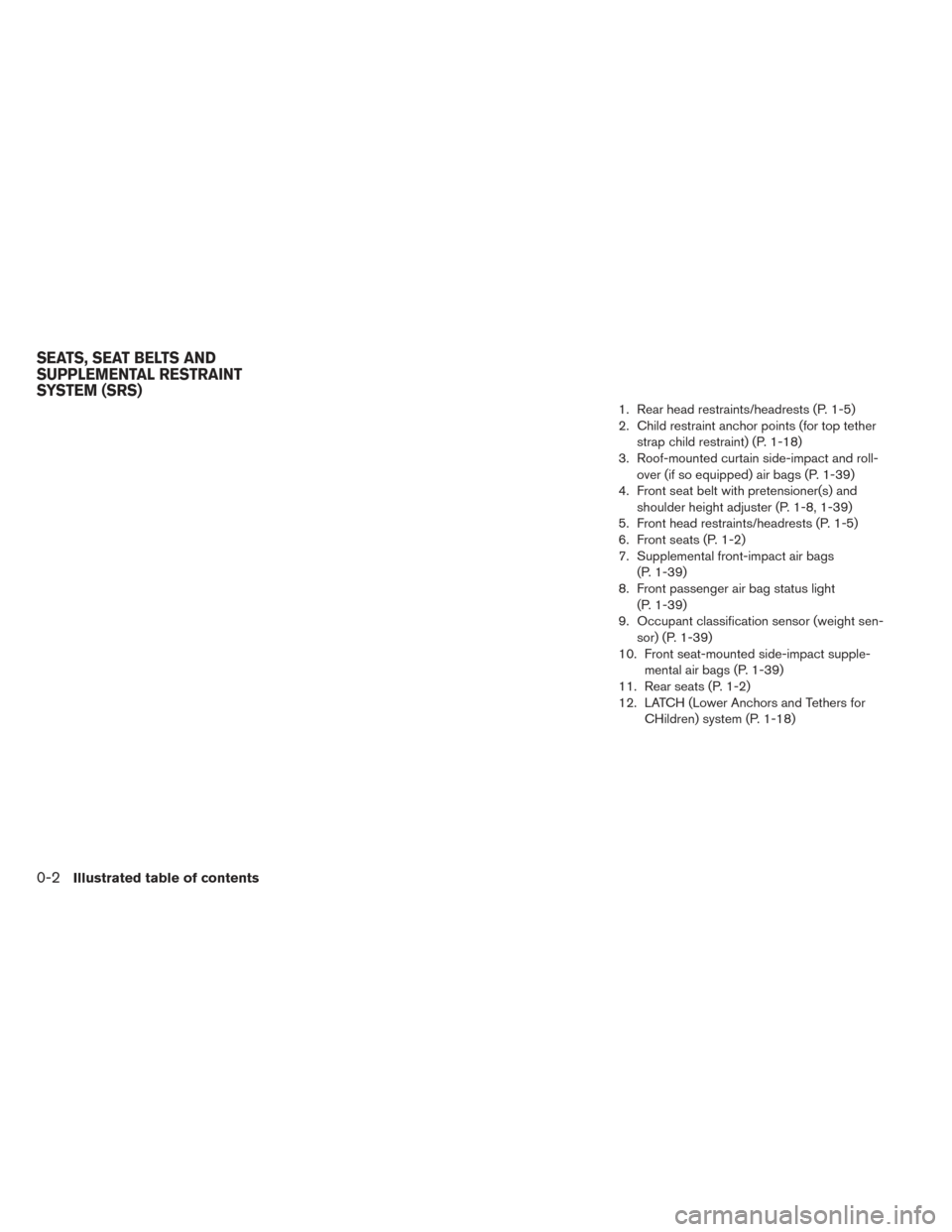
1. Rear head restraints/headrests (P. 1-5)
2. Child restraint anchor points (for top tetherstrap child restraint) (P. 1-18)
3. Roof-mounted curtain side-impact and roll- over (if so equipped) air bags (P. 1-39)
4. Front seat belt with pretensioner(s) and shoulder height adjuster (P. 1-8, 1-39)
5. Front head restraints/headrests (P. 1-5)
6. Front seats (P. 1-2)
7. Supplemental front-impact air bags (P. 1-39)
8. Front passenger air bag status light (P. 1-39)
9. Occupant classification sensor (weight sen- sor) (P. 1-39)
10. Front seat-mounted side-impact supple- mental air bags (P. 1-39)
11. Rear seats (P. 1-2)
12. LATCH (Lower Anchors and Tethers for CHildren) system (P. 1-18)
SEATS, SEAT BELTS AND
SUPPLEMENTAL RESTRAINT
SYSTEM (SRS)
0-2Illustrated table of contents
Page 124 of 424
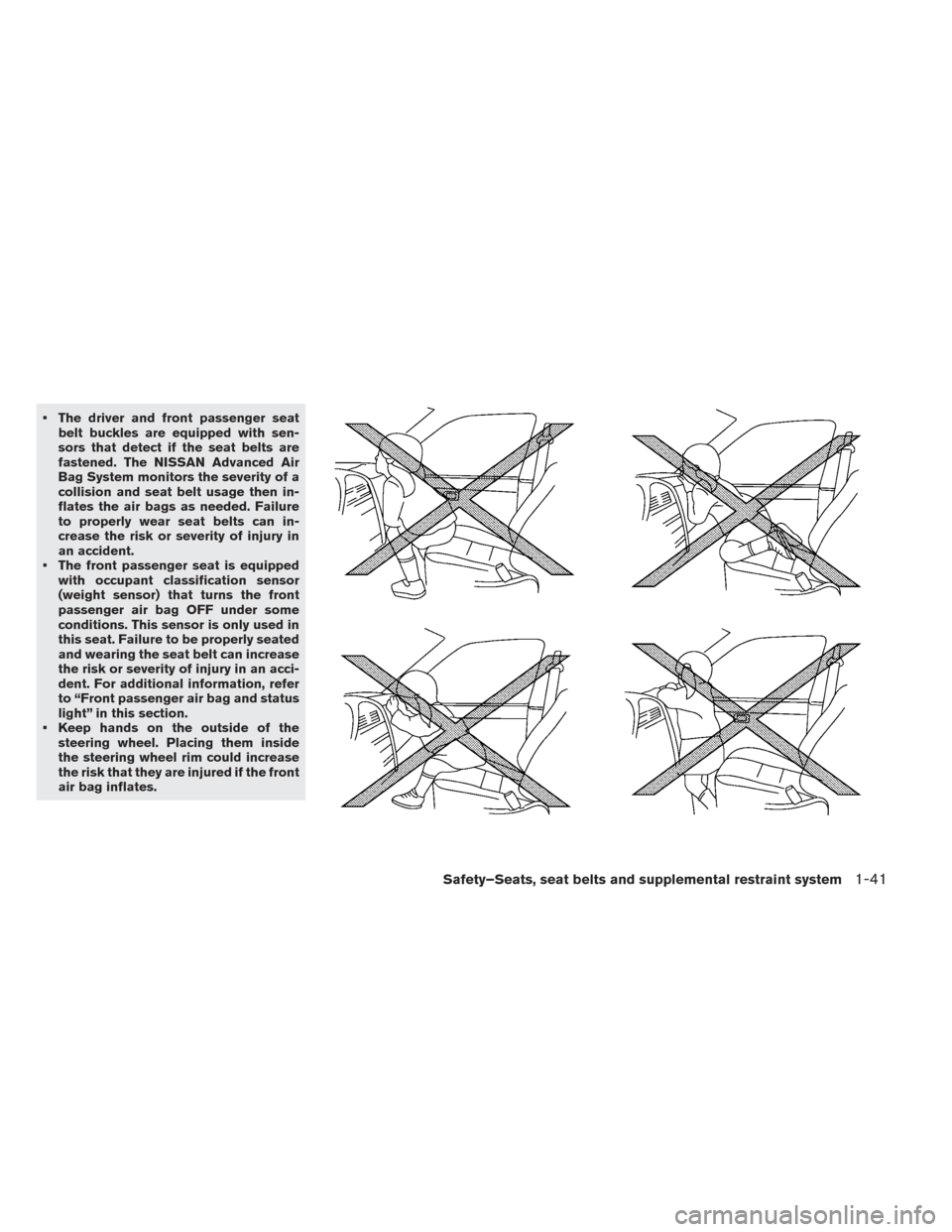
• The driver and front passenger seatbelt buckles are equipped with sen-
sors that detect if the seat belts are
fastened. The NISSAN Advanced Air
Bag System monitors the severity of a
collision and seat belt usage then in-
flates the air bags as needed. Failure
to properly wear seat belts can in-
crease the risk or severity of injury in
an accident.
• The front passenger seat is equipped with occupant classification sensor
(weight sensor) that turns the front
passenger air bag OFF under some
conditions. This sensor is only used in
this seat. Failure to be properly seated
and wearing the seat belt can increase
the risk or severity of injury in an acci-
dent. For additional information, refer
to “Front passenger air bag and status
light” in this section.
• Keep hands on the outside of the steering wheel. Placing them inside
the steering wheel rim could increase
the risk that they are injured if the front
air bag inflates.
Safety–Seats, seat belts and supplemental restraint system1-41
Page 127 of 424
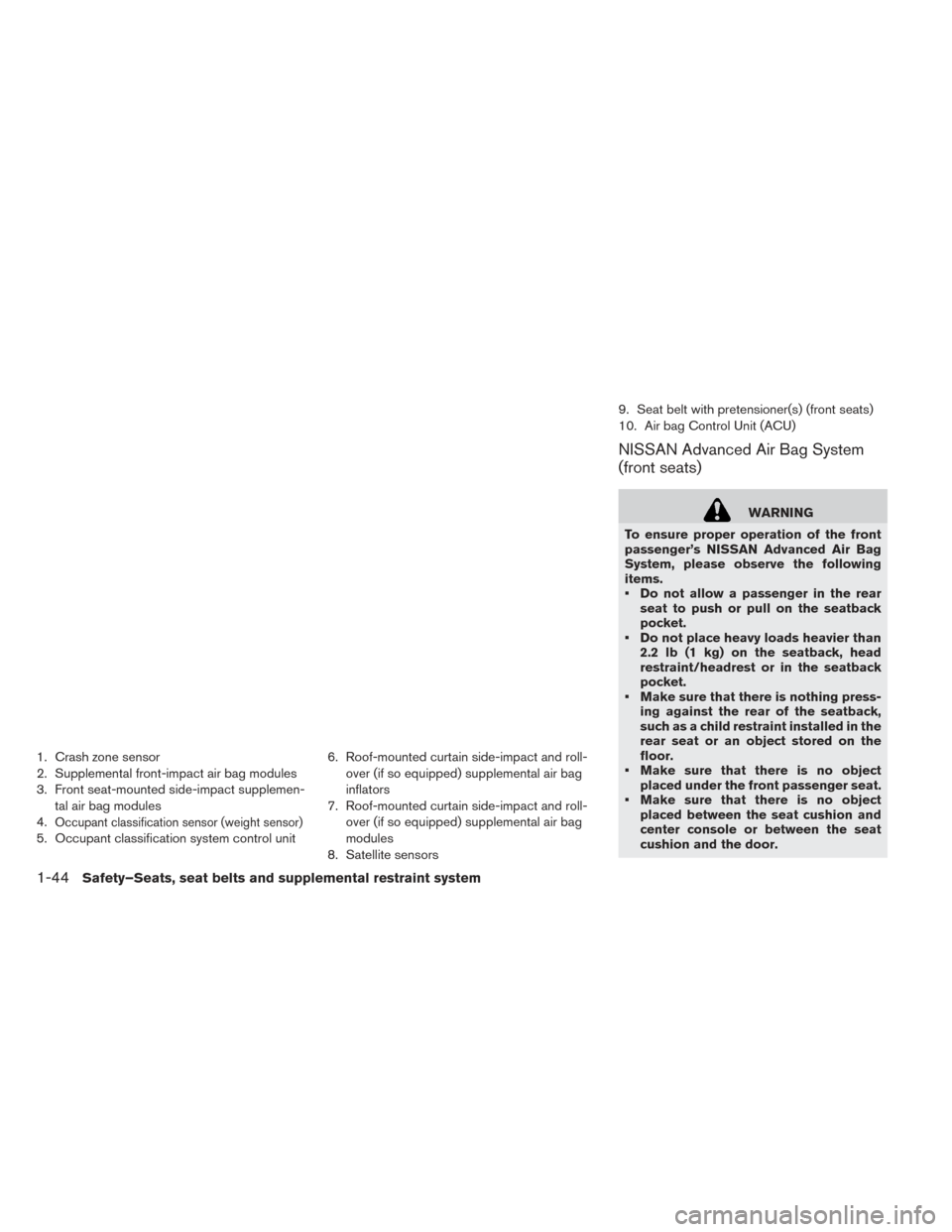
1. Crash zone sensor
2. Supplemental front-impact air bag modules
3. Front seat-mounted side-impact supplemen-tal air bag modules
4.
Occupant classification sensor (weight sensor)
5. Occupant classification system control unit 6. Roof-mounted curtain side-impact and roll-
over (if so equipped) supplemental air bag
inflators
7. Roof-mounted curtain side-impact and roll- over (if so equipped) supplemental air bag
modules
8. Satellite sensors 9. Seat belt with pretensioner(s) (front seats)
10. Air bag Control Unit (ACU)
NISSAN Advanced Air Bag System
(front seats)
WARNING
To ensure proper operation of the front
passenger’s NISSAN Advanced Air Bag
System, please observe the following
items.
• Do not allow a passenger in the rear seat to push or pull on the seatback
pocket.
• Do not place heavy loads heavier than 2.2 lb (1 kg) on the seatback, head
restraint/headrest or in the seatback
pocket.
• Make sure that there is nothing press- ing against the rear of the seatback,
such as a child restraint installed in the
rear seat or an object stored on the
floor.
• Make sure that there is no object placed under the front passenger seat.
• Make sure that there is no object placed between the seat cushion and
center console or between the seat
cushion and the door.
1-44Safety–Seats, seat belts and supplemental restraint system
Page 128 of 424
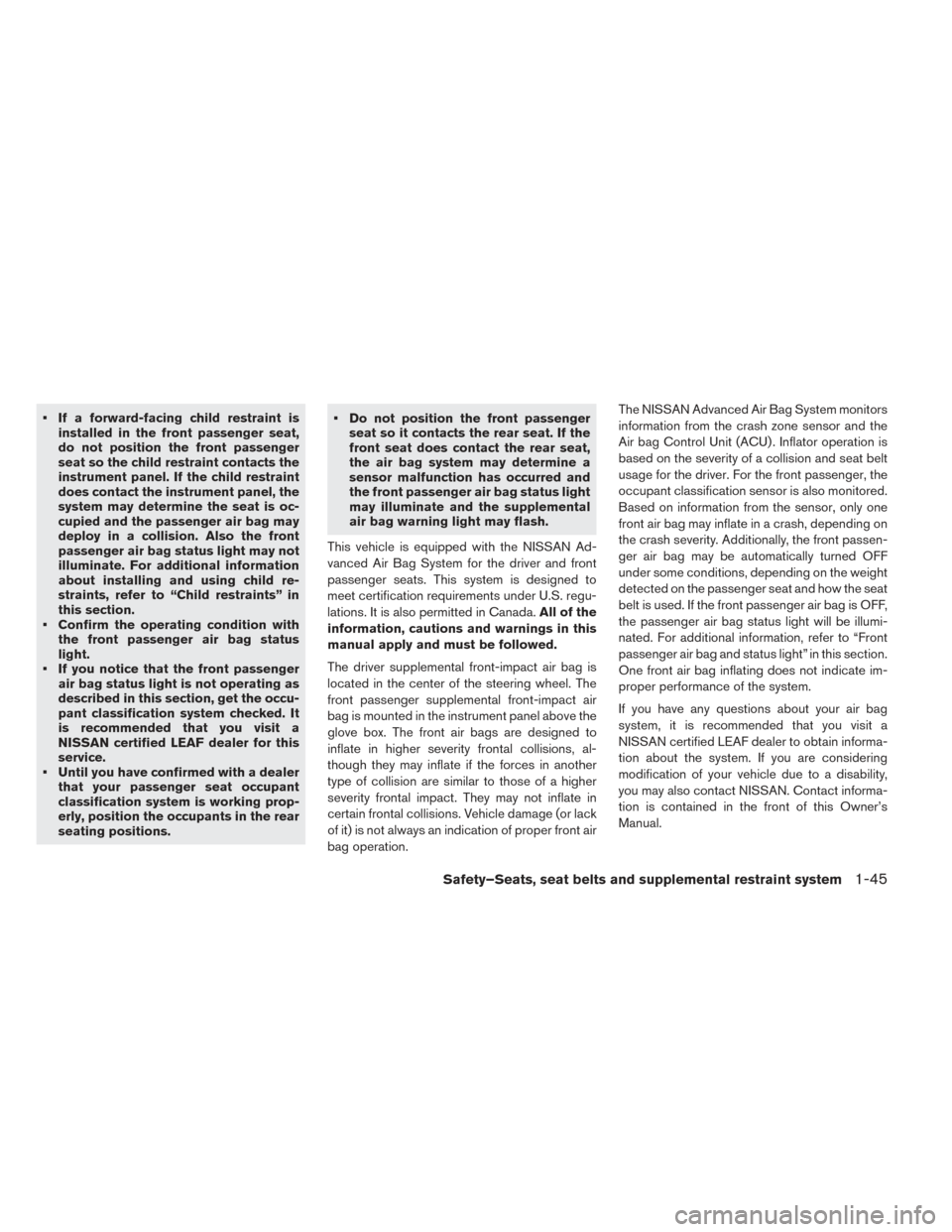
• If a forward-facing child restraint isinstalled in the front passenger seat,
do not position the front passenger
seat so the child restraint contacts the
instrument panel. If the child restraint
does contact the instrument panel, the
system may determine the seat is oc-
cupied and the passenger air bag may
deploy in a collision. Also the front
passenger air bag status light may not
illuminate. For additional information
about installing and using child re-
straints, refer to “Child restraints” in
this section.
• Confirm the operating condition with the front passenger air bag status
light.
• If you notice that the front passenger air bag status light is not operating as
described in this section, get the occu-
pant classification system checked. It
is recommended that you visit a
NISSAN certified LEAF dealer for this
service.
• Until you have confirmed with a dealer that your passenger seat occupant
classification system is working prop-
erly, position the occupants in the rear
seating positions. • Do not position the front passenger
seat so it contacts the rear seat. If the
front seat does contact the rear seat,
the air bag system may determine a
sensor malfunction has occurred and
the front passenger air bag status light
may illuminate and the supplemental
air bag warning light may flash.
This vehicle is equipped with the NISSAN Ad-
vanced Air Bag System for the driver and front
passenger seats. This system is designed to
meet certification requirements under U.S. regu-
lations. It is also permitted in Canada. All of the
information, cautions and warnings in this
manual apply and must be followed.
The driver supplemental front-impact air bag is
located in the center of the steering wheel. The
front passenger supplemental front-impact air
bag is mounted in the instrument panel above the
glove box. The front air bags are designed to
inflate in higher severity frontal collisions, al-
though they may inflate if the forces in another
type of collision are similar to those of a higher
severity frontal impact. They may not inflate in
certain frontal collisions. Vehicle damage (or lack
of it) is not always an indication of proper front air
bag operation. The NISSAN Advanced Air Bag System monitors
information from the crash zone sensor and the
Air bag Control Unit (ACU) . Inflator operation is
based on the severity of a collision and seat belt
usage for the driver. For the front passenger, the
occupant classification sensor is also monitored.
Based on information from the sensor, only one
front air bag may inflate in a crash, depending on
the crash severity. Additionally, the front passen-
ger air bag may be automatically turned OFF
under some conditions, depending on the weight
detected on the passenger seat and how the seat
belt is used. If the front passenger air bag is OFF,
the passenger air bag status light will be illumi-
nated. For additional information, refer to “Front
passenger air bag and status light” in this section.
One front air bag inflating does not indicate im-
proper performance of the system.
If you have any questions about your air bag
system, it is recommended that you visit a
NISSAN certified LEAF dealer to obtain informa-
tion about the system. If you are considering
modification of your vehicle due to a disability,
you may also contact NISSAN. Contact informa-
tion is contained in the front of this Owner’s
Manual.
Safety–Seats, seat belts and supplemental restraint system1-45
Page 130 of 424
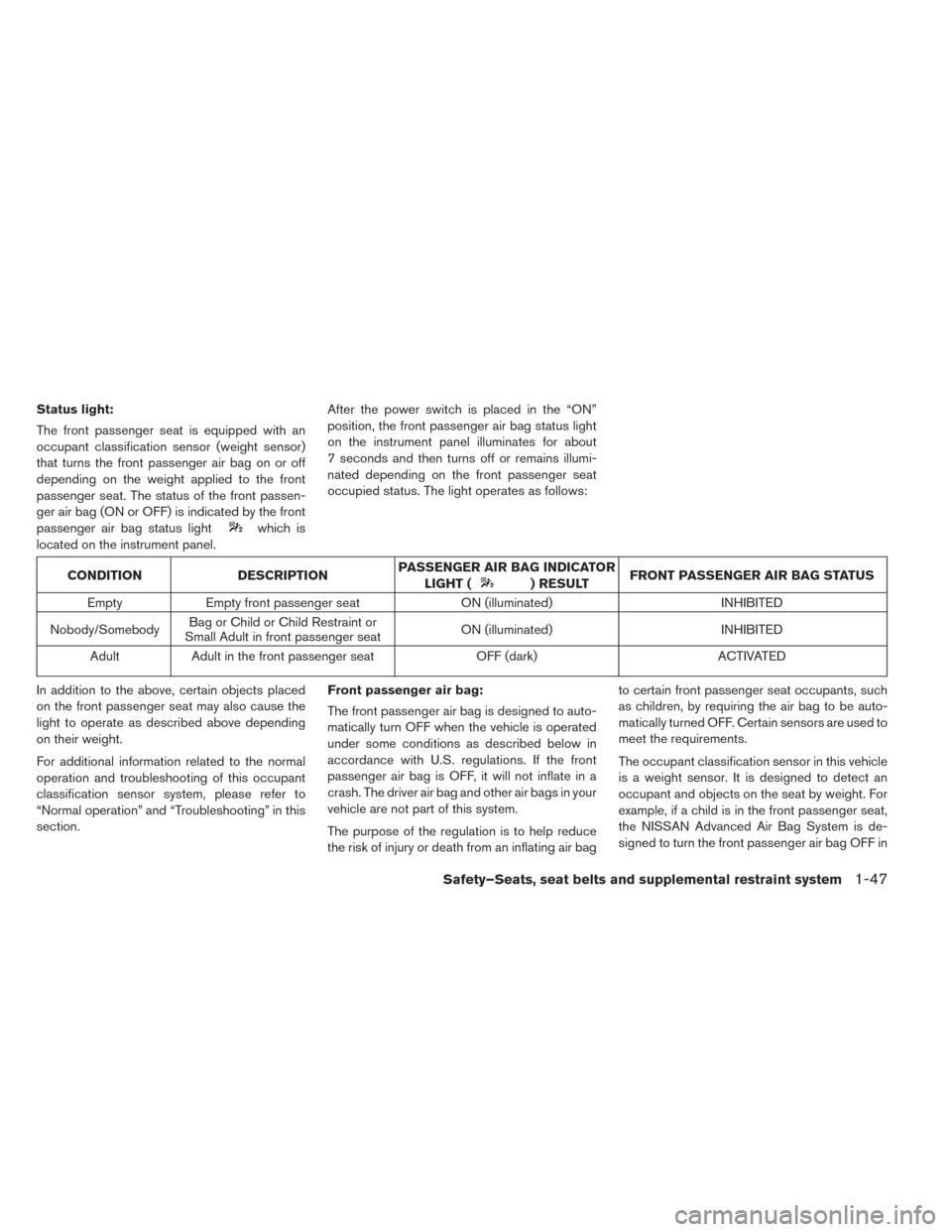
Status light:
The front passenger seat is equipped with an
occupant classification sensor (weight sensor)
that turns the front passenger air bag on or off
depending on the weight applied to the front
passenger seat. The status of the front passen-
ger air bag (ON or OFF) is indicated by the front
passenger air bag status light
which is
located on the instrument panel. After the power switch is placed in the “ON”
position, the front passenger air bag status light
on the instrument panel illuminates for about
7 seconds and then turns off or remains illumi-
nated depending on the front passenger seat
occupied status. The light operates as follows:
CONDITION
DESCRIPTIONPASSENGER AIR BAG INDICATOR
LIGHT () RESULT FRONT PASSENGER AIR BAG STATUS
Empty Empty front passenger seat ON (illuminated) INHIBITED
Nobody/Somebody Bag or Child or Child Restraint or
Small Adult in front passenger seat ON (illuminated)
INHIBITED
Adult Adult in the front passenger seat OFF (dark)ACTIVATED
In addition to the above, certain objects placed
on the front passenger seat may also cause the
light to operate as described above depending
on their weight.
For additional information related to the normal
operation and troubleshooting of this occupant
classification sensor system, please refer to
“Normal operation” and “Troubleshooting” in this
section. Front passenger air bag:
The front passenger air bag is designed to auto-
matically turn OFF when the vehicle is operated
under some conditions as described below in
accordance with U.S. regulations. If the front
passenger air bag is OFF, it will not inflate in a
crash. The driver air bag and other air bags in your
vehicle are not part of this system.
The purpose of the regulation is to help reduce
the risk of injury or death from an inflating air bagto certain front passenger seat occupants, such
as children, by requiring the air bag to be auto-
matically turned OFF. Certain sensors are used to
meet the requirements.
The occupant classification sensor in this vehicle
is a weight sensor. It is designed to detect an
occupant and objects on the seat by weight. For
example, if a child is in the front passenger seat,
the NISSAN Advanced Air Bag System is de-
signed to turn the front passenger air bag OFF in
Safety–Seats, seat belts and supplemental restraint system1-47
Page 131 of 424
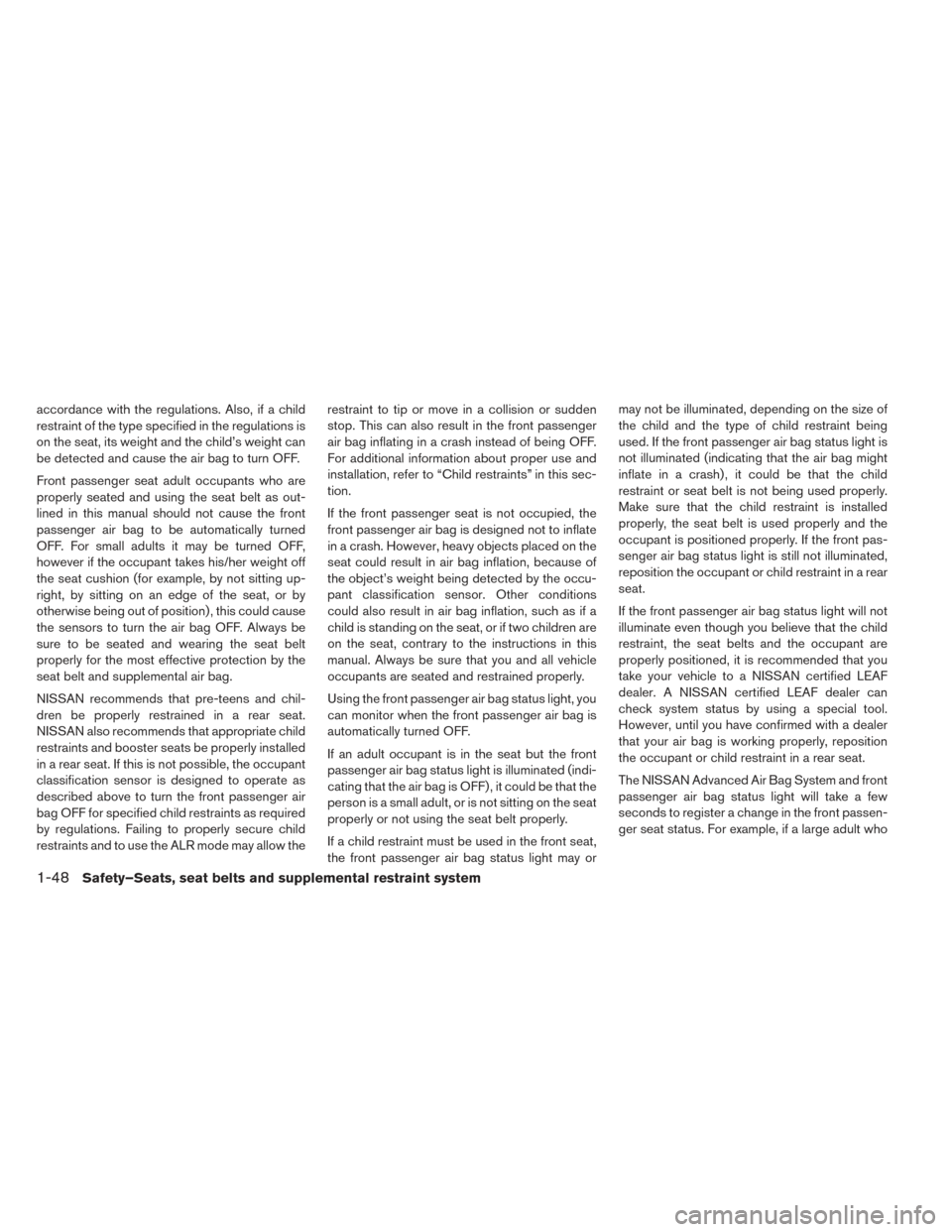
accordance with the regulations. Also, if a child
restraint of the type specified in the regulations is
on the seat, its weight and the child’s weight can
be detected and cause the air bag to turn OFF.
Front passenger seat adult occupants who are
properly seated and using the seat belt as out-
lined in this manual should not cause the front
passenger air bag to be automatically turned
OFF. For small adults it may be turned OFF,
however if the occupant takes his/her weight off
the seat cushion (for example, by not sitting up-
right, by sitting on an edge of the seat, or by
otherwise being out of position) , this could cause
the sensors to turn the air bag OFF. Always be
sure to be seated and wearing the seat belt
properly for the most effective protection by the
seat belt and supplemental air bag.
NISSAN recommends that pre-teens and chil-
dren be properly restrained in a rear seat.
NISSAN also recommends that appropriate child
restraints and booster seats be properly installed
in a rear seat. If this is not possible, the occupant
classification sensor is designed to operate as
described above to turn the front passenger air
bag OFF for specified child restraints as required
by regulations. Failing to properly secure child
restraints and to use the ALR mode may allow therestraint to tip or move in a collision or sudden
stop. This can also result in the front passenger
air bag inflating in a crash instead of being OFF.
For additional information about proper use and
installation, refer to “Child restraints” in this sec-
tion.
If the front passenger seat is not occupied, the
front passenger air bag is designed not to inflate
in a crash. However, heavy objects placed on the
seat could result in air bag inflation, because of
the object’s weight being detected by the occu-
pant classification sensor. Other conditions
could also result in air bag inflation, such as if a
child is standing on the seat, or if two children are
on the seat, contrary to the instructions in this
manual. Always be sure that you and all vehicle
occupants are seated and restrained properly.
Using the front passenger air bag status light, you
can monitor when the front passenger air bag is
automatically turned OFF.
If an adult occupant is in the seat but the front
passenger air bag status light is illuminated (indi-
cating that the air bag is OFF) , it could be that the
person is a small adult, or is not sitting on the seat
properly or not using the seat belt properly.
If a child restraint must be used in the front seat,
the front passenger air bag status light may ormay not be illuminated, depending on the size of
the child and the type of child restraint being
used. If the front passenger air bag status light is
not illuminated (indicating that the air bag might
inflate in a crash) , it could be that the child
restraint or seat belt is not being used properly.
Make sure that the child restraint is installed
properly, the seat belt is used properly and the
occupant is positioned properly. If the front pas-
senger air bag status light is still not illuminated,
reposition the occupant or child restraint in a rear
seat.
If the front passenger air bag status light will not
illuminate even though you believe that the child
restraint, the seat belts and the occupant are
properly positioned, it is recommended that you
take your vehicle to a NISSAN certified LEAF
dealer. A NISSAN certified LEAF dealer can
check system status by using a special tool.
However, until you have confirmed with a dealer
that your air bag is working properly, reposition
the occupant or child restraint in a rear seat.
The NISSAN Advanced Air Bag System and front
passenger air bag status light will take a few
seconds to register a change in the front passen-
ger seat status. For example, if a large adult who
1-48Safety–Seats, seat belts and supplemental restraint system
Page 132 of 424
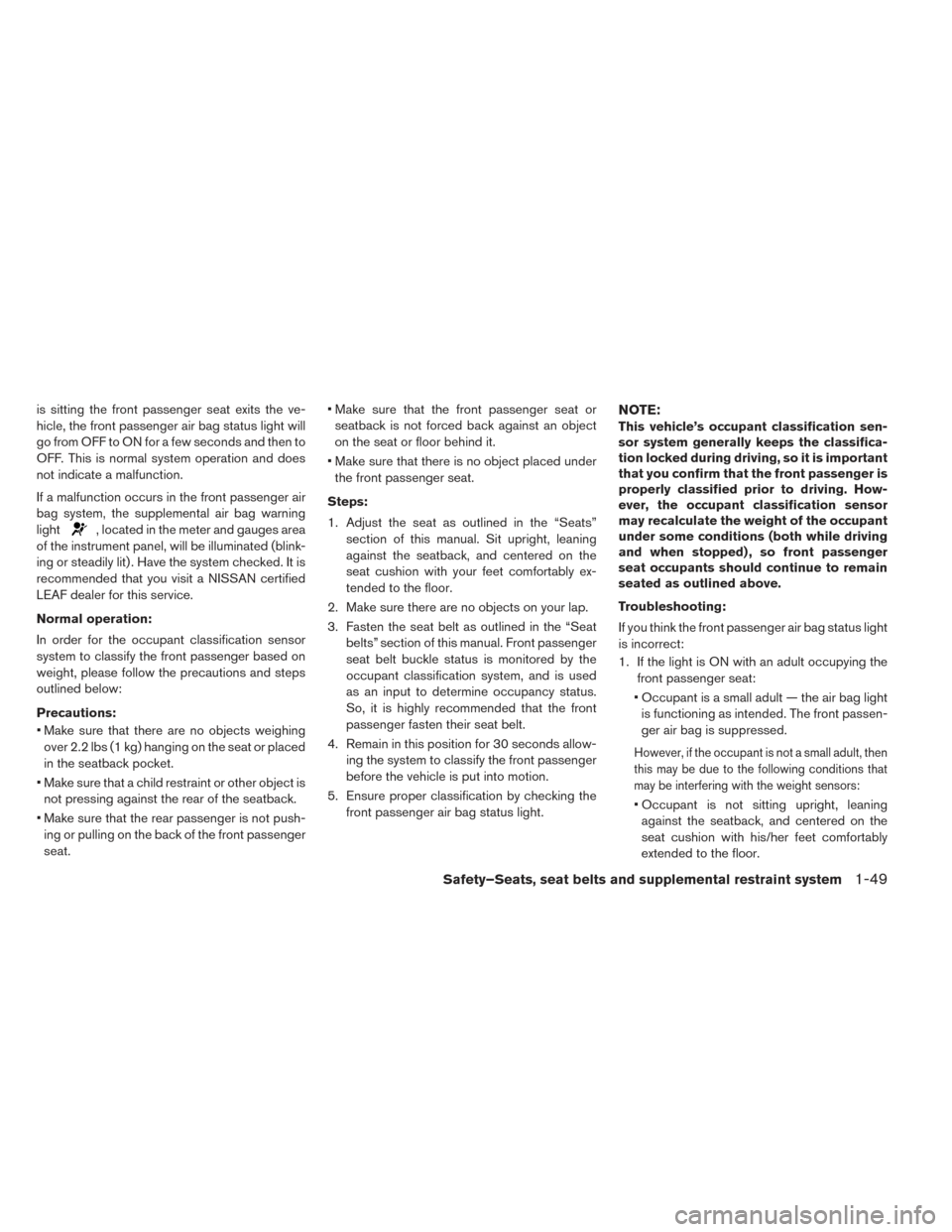
is sitting the front passenger seat exits the ve-
hicle, the front passenger air bag status light will
go from OFF to ON for a few seconds and then to
OFF. This is normal system operation and does
not indicate a malfunction.
If a malfunction occurs in the front passenger air
bag system, the supplemental air bag warning
light
, located in the meter and gauges area
of the instrument panel, will be illuminated (blink-
ing or steadily lit) . Have the system checked. It is
recommended that you visit a NISSAN certified
LEAF dealer for this service.
Normal operation:
In order for the occupant classification sensor
system to classify the front passenger based on
weight, please follow the precautions and steps
outlined below:
Precautions:
• Make sure that there are no objects weighing over 2.2 lbs (1 kg) hanging on the seat or placed
in the seatback pocket.
• Make sure that a child restraint or other object is not pressing against the rear of the seatback.
• Make sure that the rear passenger is not push- ing or pulling on the back of the front passenger
seat. • Make sure that the front passenger seat or
seatback is not forced back against an object
on the seat or floor behind it.
• Make sure that there is no object placed under the front passenger seat.
Steps:
1. Adjust the seat as outlined in the “Seats” section of this manual. Sit upright, leaning
against the seatback, and centered on the
seat cushion with your feet comfortably ex-
tended to the floor.
2. Make sure there are no objects on your lap.
3. Fasten the seat belt as outlined in the “Seat belts” section of this manual. Front passenger
seat belt buckle status is monitored by the
occupant classification system, and is used
as an input to determine occupancy status.
So, it is highly recommended that the front
passenger fasten their seat belt.
4. Remain in this position for 30 seconds allow- ing the system to classify the front passenger
before the vehicle is put into motion.
5. Ensure proper classification by checking the front passenger air bag status light.
NOTE:
This vehicle’s occupant classification sen-
sor system generally keeps the classifica-
tion locked during driving, so it is important
that you confirm that the front passenger is
properly classified prior to driving. How-
ever, the occupant classification sensor
may recalculate the weight of the occupant
under some conditions (both while driving
and when stopped) , so front passenger
seat occupants should continue to remain
seated as outlined above.
Troubleshooting:
If you think the front passenger air bag status light
is incorrect:
1. If the light is ON with an adult occupying thefront passenger seat:
• Occupant is a small adult — the air bag light is functioning as intended. The front passen-
ger air bag is suppressed.
However, if the occupant is not a small adult, then
this may be due to the following conditions that
may be interfering with the weight sensors:
• Occupant is not sitting upright, leaningagainst the seatback, and centered on the
seat cushion with his/her feet comfortably
extended to the floor.
Safety–Seats, seat belts and supplemental restraint system1-49
Page 134 of 424
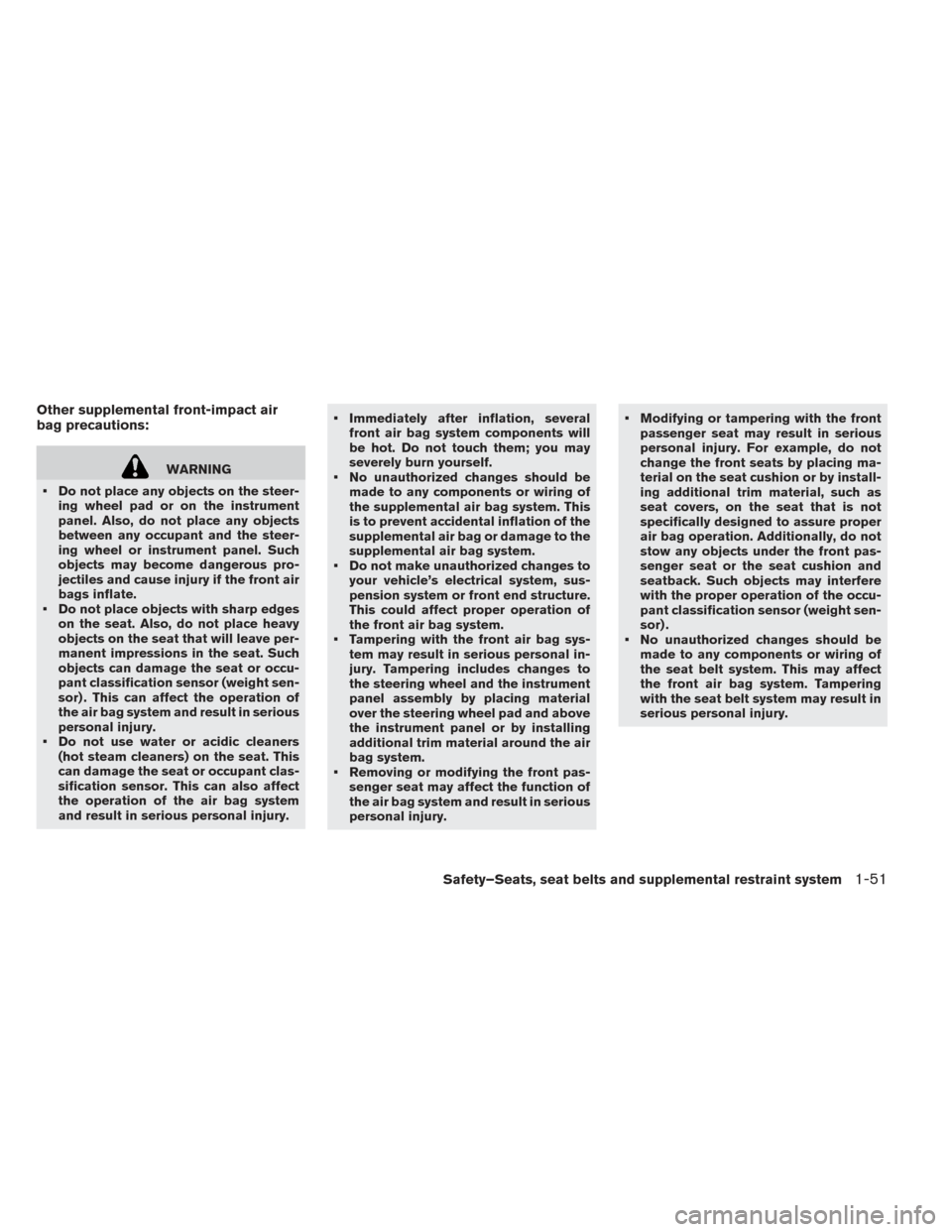
Other supplemental front-impact air
bag precautions:
WARNING
• Do not place any objects on the steer- ing wheel pad or on the instrument
panel. Also, do not place any objects
between any occupant and the steer-
ing wheel or instrument panel. Such
objects may become dangerous pro-
jectiles and cause injury if the front air
bags inflate.
• Do not place objects with sharp edges on the seat. Also, do not place heavy
objects on the seat that will leave per-
manent impressions in the seat. Such
objects can damage the seat or occu-
pant classification sensor (weight sen-
sor) . This can affect the operation of
the air bag system and result in serious
personal injury.
• Do not use water or acidic cleaners (hot steam cleaners) on the seat. This
can damage the seat or occupant clas-
sification sensor. This can also affect
the operation of the air bag system
and result in serious personal injury. • Immediately after inflation, several
front air bag system components will
be hot. Do not touch them; you may
severely burn yourself.
• No unauthorized changes should be made to any components or wiring of
the supplemental air bag system. This
is to prevent accidental inflation of the
supplemental air bag or damage to the
supplemental air bag system.
• Do not make unauthorized changes to your vehicle’s electrical system, sus-
pension system or front end structure.
This could affect proper operation of
the front air bag system.
• Tampering with the front air bag sys- tem may result in serious personal in-
jury. Tampering includes changes to
the steering wheel and the instrument
panel assembly by placing material
over the steering wheel pad and above
the instrument panel or by installing
additional trim material around the air
bag system.
• Removing or modifying the front pas- senger seat may affect the function of
the air bag system and result in serious
personal injury. • Modifying or tampering with the front
passenger seat may result in serious
personal injury. For example, do not
change the front seats by placing ma-
terial on the seat cushion or by install-
ing additional trim material, such as
seat covers, on the seat that is not
specifically designed to assure proper
air bag operation. Additionally, do not
stow any objects under the front pas-
senger seat or the seat cushion and
seatback. Such objects may interfere
with the proper operation of the occu-
pant classification sensor (weight sen-
sor) .
• No unauthorized changes should be made to any components or wiring of
the seat belt system. This may affect
the front air bag system. Tampering
with the seat belt system may result in
serious personal injury.
Safety–Seats, seat belts and supplemental restraint system1-51